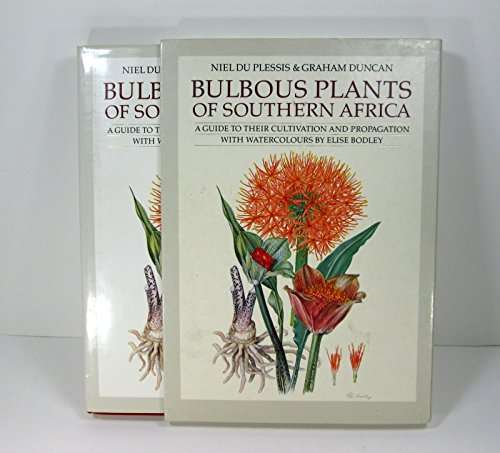"BULBOUS PLANTS OF SOUTHERN AFRICA" BY N DU PLESSIS & G DUNCAN, HARDCOVER IN FINE SLIPCASE, 1989 FIRST EDITION, 192 PAGES, NO NAMES OR INSCRIPTIONS. IN EXCELLENT CONDITION.
Of all the plants in the rich Southern African flora, none offer the gardener more beauty and variety than the geophytes (commonly referred to as bulbous plants- which include bulbs, corms, rhizomes and tubers). Yet the recent surge of interest in cultivating indigenous plants has for the most part strangely passed them by. This richly illustrated gardeners' and plant-lovers' guide to the wonderfully varied and beautiful bulbous plants of Southern Africa puts an end to this neglect- Niel Du Plessis and Graham Duncan blend botany with practical expertise to shed new light on a range of exciting plants known previously to only a few enthusiasts. They succeed, too, in dispelling the myth that most of these bulbous plants are difficult to grow.
Part One covers the botanical ground and deals with topics such as floristic regions of Southern Africa; nomenclature; general principals of cultivation(including discussions of the cultivation of the deciduous winter and summer-growers, and the evergreens); propagation; and the control of pests and diseases.
Part Two deals with the plants themselves. Each chapter is devoted to a separate family, and discusses matters such as distribution and morphology of each genus, medicinal uses, growth cycles, methods of cultivation and propagation, and pests and diseases, before moving on to the descriptions of those species the author consider most worth growing. All in all about 700 species are described and over 300 plants illustrated in 47 colour plates. Hardiness ratings are given where these are known.
A particularly valuable feature of the book for enthusiasts outside Southern Africa is the discussion of the problems of acclimatising root stocks to the Northern Hemisphere. Full lists of references are given throughout the text, and there is a general bibliography and a comprehensive index. Hardback with dustcover over crimson boards with vignette to front board and gilt lettering to spine. Illustrated map endpapers. 192 pages text with supporting colour plates. With matching slipcase.It begins with an extensive section on cultivation and propagation, with useful monochrome illustrations. The heart of the book consists of a treatment of the most desirable members of each genus, together with watercolours by Elise Bodley. In some cases the watercolours are mixed compositions from within one genus, others combine small genera from the same family.


